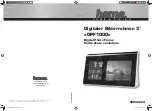
BOBCAT Hardware User’s Manual
Imperx, Inc.
Rev. 2.0.2
6421 Congress Ave.
11/20/2012
Boca Raton, FL 33487
+1 (561) 989-0006
151 of 265
4.1 OVERVIEW
The Bobcat series of cameras are highly programmable and flexible. All of the
cameras resources (internal registers, video amplifiers and parameter FLASH) can
be controlled by the user. The user communicates with the camera using a simple,
register-based, command protocol via the Camera Link‟s serial interface. The
interface is bi-directional with the user issuing „commands‟ to the camera and the
camera issuing „responses‟ (either status or info) to the user. The entire camera
registers and resources can be configured and monitored by the user. The
camera‟s parameters can be programmed using the Bobcat Configurator graphical
user interface.
4.2 CAMERA CONFIGURATION
4.2.1
Configuration Memory
– parameter FLASH
The camera has a built-in configuration memory divided into 4 segments: „work-
space‟, „factory-space‟, „user-space #1‟ and „user-space #2‟. The „work-space‟
segment contains the current camera settings while the camera is powered-up and
operational. All camera registers are located in this space. These registers can be
programmed and retrieved via commands issued by the user. The workspace is
RAM based and upon power down all camera registers are cleared. The „factory-
space‟ segment is ROM based, write protected and contains the default camera
settings. This space is available for read operations only. The „user-space #1‟ and
„user-space #2‟ are non-volatile, FLASH based and used to store two user defined
configurations. Upon power up, the camera firmware loads the work-space
registers from the factory-space, user-space #1 or user-space #2 as determined by
a „boot control‟ register located in the configuration memory. The „boot control‟
register can be programmed by the user (refer to Camera Configuration Section).
The user can, at any time, instruct the camera to loads its workspace with the
contents of the „factory-space‟, „user-space #1‟ or „user-space #2‟. Similarly, the
user can instruct the camera to save the current workspace settings into either the
„user-space #1‟ or „user-space #2‟.
The non-volatile parameter FLASH memory also contains Defective Pixel Map,
Hot Pixel Map, Flat Field Correction Coefficients, LUT 1 and LUT 2, which can
be loaded to the camera internal memory upon enabling the corresponding camera
feature. The user can create its own DPM, HPM, FFCC, and LUT tables and
upload them to the parameter FLASH using the Bobcat Configurator graphical
user interface.
















































